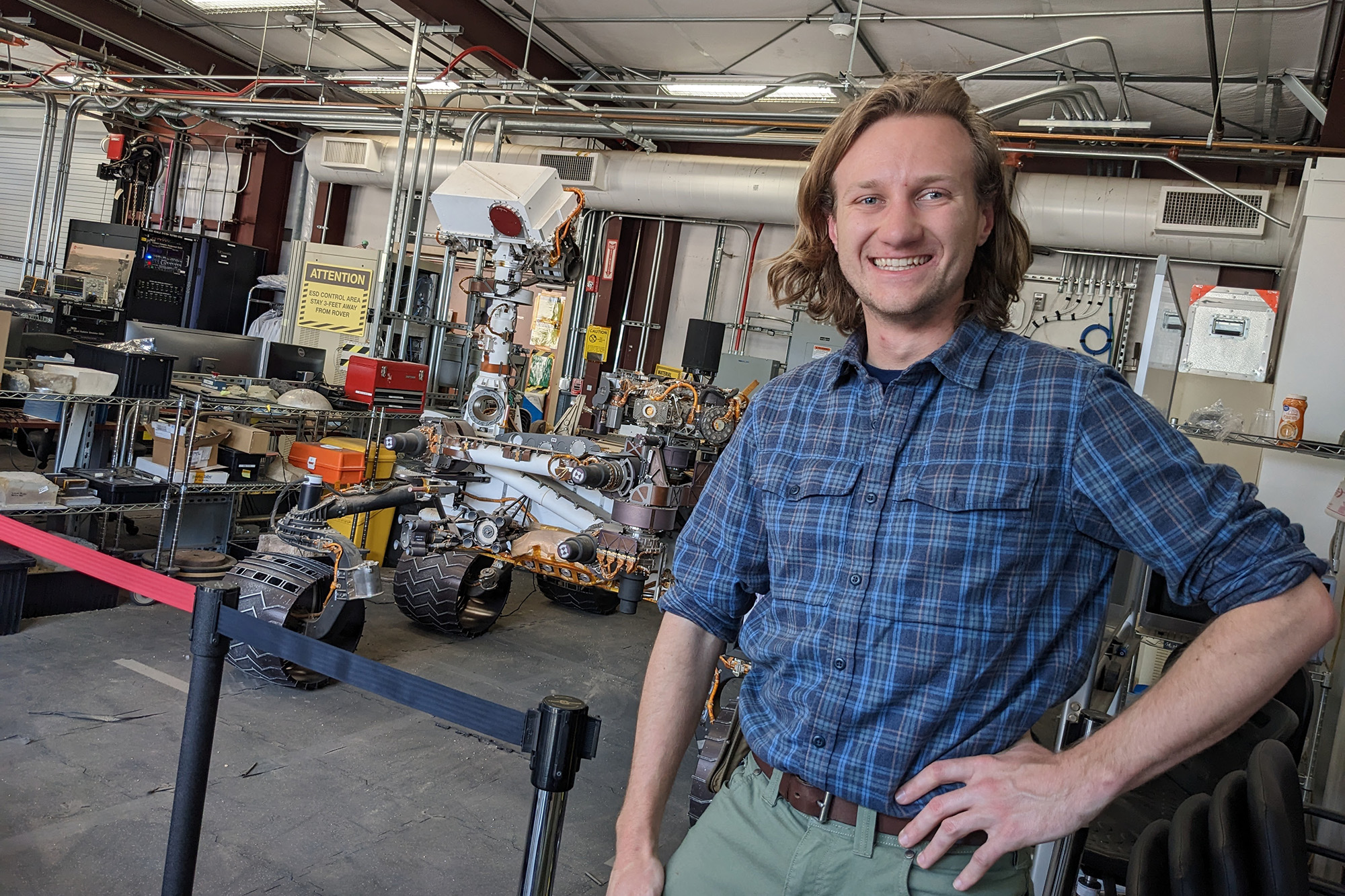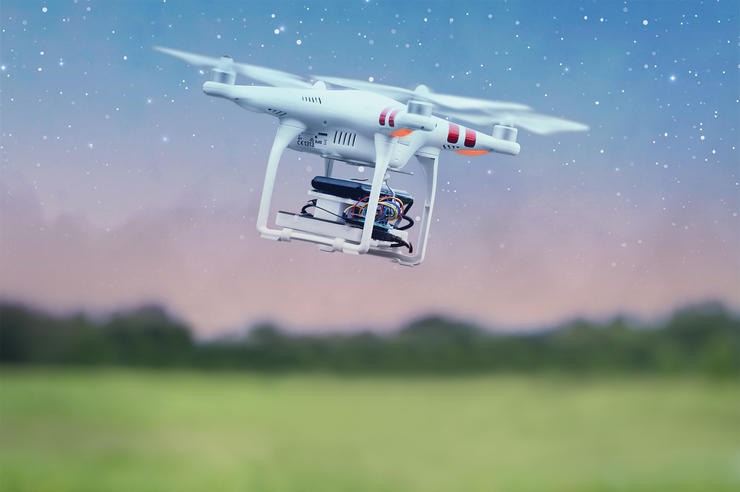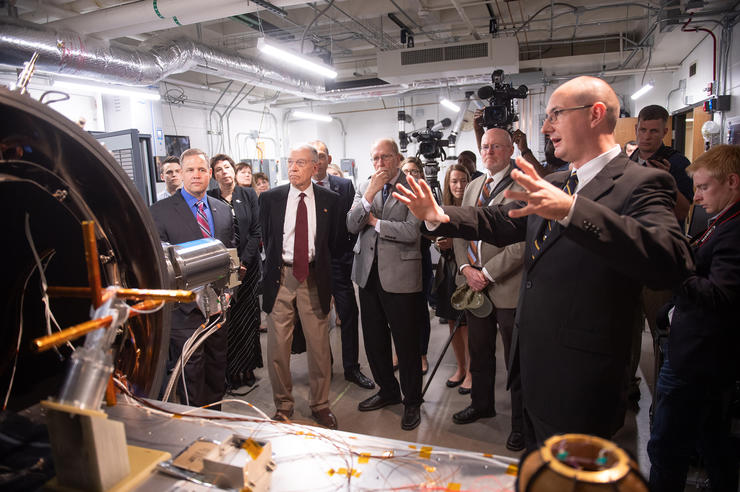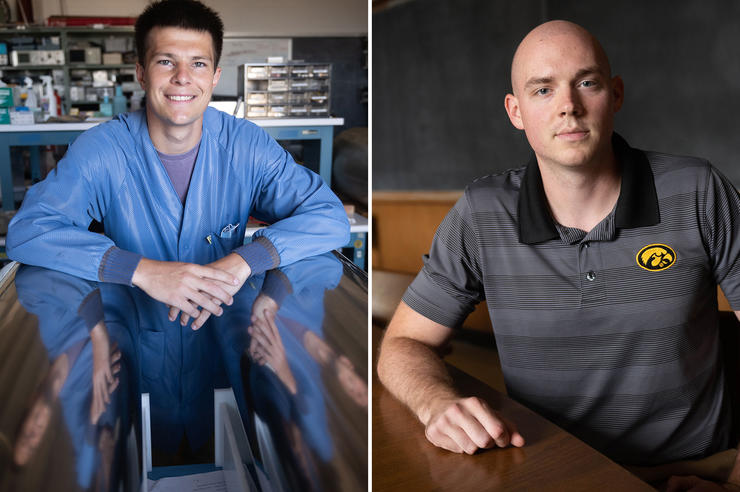Iowa student designs big-ticket mission at NASA school

How do you dream up a space mission?
Just ask Jacob Payne, a second-year graduate student in physics and astronomy at the University of Iowa. The Atlanta native did just that at NASA’s Astrophysics Mission Design School earlier this year. Payne was the only graduate student from Iowa and one of a select group nationwide to be accepted into the program, the first ever in astrophysics offered by NASA with the goal to teach graduate students how to write proposals for grand-idea, big-budget missions.
Payne’s team proposed a viable—albeit hypothetical—$1 billion mission to study extreme ultraviolet light, such as that emitted by supernovas, or exploding stars. Payne, chosen by his peers to be mission systems engineer, was responsible for leading a group that proposed how to produce the instruments needed to observe and analyze the ultraviolet light.
“I know proposing your own mission is going to be tough, but now I’ve done it at [NASA’s] Astrophysics Mission Design School. Ideally, I’ll have more time to get it all ready when I have a mission for real.”
Payne emerged from the 11-week program enthused with the prospect of dreaming up his own mission and emboldened with newfound knowledge on how to do it.
“I have confidence in a whole new way,” Payne says. “I know proposing your own mission is going to be tough, but now I’ve done it at the Astrophysics Mission Design School. Ideally, I’ll have more time to get it all ready when I have a mission for real.”
The Astrophysics Mission Design School gave Payne a complete view of what a full mission entails, what he calls the “overall science story.”
“It’s getting a broader picture as the principal investigator of a mission,” Payne says. “How will you process data? What science questions are you asking? And how do you prove that this mission will be able to answer those questions, with the measurements you want to take?”
Jacob Payne came to the University of Iowa via Blue Canyon Technologies, the premier small-satellite vendor in the U.S. While at Blue Canyon, he learned about HaloSat, the Iowa-led initiative that launched in 2018 and was the first competitively selected CubeSat mission funded by NASA’s Astrophysics Division. CubeSats are the newer generation class of satellites the size of a shoebox, meaning they are less expensive and nimbler than traditional space science vehicles.
“I’d heard about HaloSat since I had been working at Blue Canyon, and that’s how I became aware of Iowa,” Payne says. “And when I started digging into schools with programs related to X-ray optics, there were only three, and Iowa was one of them.”
Payne joined the research group led by Casey DeRoo, assistant professor in the Department of Physics and Astronomy who specializes in high-energy astrophysics and astronomical instrumentation. In DeRoo’s lab, Payne is working on a telescope navigation system in which spacecraft in deep space would collect X-rays from pulsars to continuously determine their location.
“If you can use X-ray navigation tools, every spacecraft can figure out its own position without using Earth as a reference point,” explains Payne. “The accuracy on that currently is about a two-kilometer (1.2 miles) scale. So, for any mission that’s out past Jupiter, this would be better than what we can do right now. And then, of course, our goal is to develop something that can be more accurate than that, so it’s useful anywhere.”
Casey DeRoo, assistant professor in the Department of Physics and Astronomy, encouraged Payne to apply for the program.
“This opportunity was great for Jacob, because you need someone who can understand, and explain, the significance of the science, while also understanding how to build something to measure and collect what you need to answer the science questions,” says DeRoo, whose research group includes Payne. “Those are very different skills, and you need that full portfolio to lead missions.”
That portfolio developed while Payne was at the school. He successfully lobbied his peers to be mission systems engineer, one of six key “hex” roles in the 18-person group. Once named, he concentrated on overseeing all engineering aspects of the mission and being in touch with other members of the engineering team as well as the overall mission group.
“It’s a management-type role,” Payne says. “There’s the responsibility of coordinating subsystem roles everyone would like to play, like the propulsion engineer or a communications engineer or thermal or mechanical engineer. My responsibility was to coordinate information and requirements across those positions.”
The school culminated in a final, frenzied week at NASA’s Jet Propulsion Laboratory (JPL) in California, where the group shadowed scientists involved in mission proposals and then pitched its own mission to a scientific expert review panel, which included the head of NASA’s astrophysics mission branch.
The pitch session was meant to mimic the real deal. The room had been configured to look like Mission Control, with the group’s slideshow proposal displayed on a center screen. At the front of the room were the mission leads. The other group members had their own stations, marked by responsibility. Payne’s station was labeled “Systems.”
Six people, including Payne, gave the presentation to the expert review panel. Payne talked in detail about various engineering facets, such as the design for the vehicle that would carry the instrumentation needed to accomplish the science objectives. The reviewers, who are career experts in each of the mission elements, were running the numbers and other data in real time, asking questions and letting the proposal group know whether their plans were viable.
“It was neat to be in their presence but also definitely intimidating,” Payne recalls. “These really are the people who do this stuff for real, who have all the expertise, who can see through embellishment such as when the numbers don’t quite close. They’ve been there themselves, and so they know exactly when we’re trying to pull something.”
Payne got a reputation for his improvisational skills when fielding questions from the reviewers—his classmates went as far as to create a bingo card entry to mark every time he pulled a verbal rabbit out of his hat.
“I had been a professional systems engineer before; that gave me a leg up,” Payne says.
After a pressure-filled week, the students landed in a hot-dogs-and-beers joint to unwind, joined by the JPL scientists. As the evening came to a close, Keith Grogan, program manager in astrophysics and heliophysics competed missions and technology at JPL, sidled up to Payne.
Grogan asked Payne how far along he was with his graduate studies, adding, “You should consider us when you’re looking for what’s next.”
“I mean, of course, I will,” Payne says, recalling the conversation. “That would be a dream come true. That’s what I’ll be working toward.”


